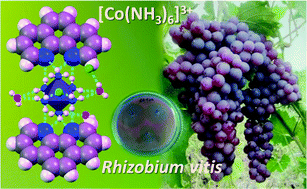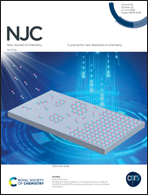Crystalline multicomponent compounds involving hexaammine cobalt(iii) cations†
Abstract
A new series of multicomponent compounds containing the cation [Co(NH3)6]3+ and various organic N-, N,O-, and O-donor moieties has been synthesized and crystallized. The series involves [Co(NH3)6]Cl3·2(phen)·3H2O (1), [Co(NH3)6](Hbdc)(bdc)·3H2O (2), [Co(NH3)6]Cl2(Hpht)·3H2O (3), [Co(NH3)6]Cl(Hpht)2·3H2O (4), [Co(NH3)6]Cl(2,3-pdc)·H2O (5), [Co(NH3)6]11[Co(2,5-pdc)3]8Cl·84H2O (6), [Co(NH3)6][Co(3,5-pdc)2(H2O)4]Cl·3H2O (7), [Co(NH3)6]Cl(sb)·4H2O (8), and [Co(NH3)6]2(sb)3·EtOH·2.5H2O (9) (where phen = 1,10-phenanthroline, H2bdc = diphenyl-4,4′-dicarboxylic acid, H2pht = o-phthalic acid, H2pdc = 2,3-/2,5-/3,5-pyridinedicarboxylic acid, H2sb = 4-sulfobenzoic acid). Single crystal X-ray diffraction studies have revealed that in these compounds the [Co(NH3)6]3+ cation serves as a building block for the incorporation of various anions/molecules and promotes the formation of multicomponent compounds with extended charge-supported networks between cations and anions and others such as H-bonds between charged⋯neutral and neutral⋯neutral components as well as π–π stacking interactions. In addition to the [Co(NH3)6]3+ cations, compounds 1–9 contain in changing composition Cl−, deprotonated phthalate, diphenyldicarboxylate, pyridinedicarboxylate, and sulfonate anions or complex [Co(2,5-pdc)3]4− and [Co(3,5-pdc)2(H2O)4]2− anions, as well as neutral 1,10-phenanthroline and ethanol and water molecules as components of the crystallization. Hirshfeld surface analysis was also performed to discuss the strength of hydrogen bonds and to quantify the inter-contacts. Energy decomposition analysis of the intermolecular interaction energy was performed using the SAPT method to study the non-covalent bonding interactions of [Co(NH3)6]3+ cations with mono-, dianions and neutral molecules, and it was found that the calculated bonding energy for compound 1 is minimal. Compounds 1–9 were tested in vitro against Rhizobium (Agrobacterium) vitis, an oncogenic bacterium that causes tumor formation in plants. Compound 1, comprising hexaammine cobalt(III) chloride and 1,10-phenanthroline, showed the highest inhibitory potential and is thus qualified for an application against bacterial cancer in plants.



 Please wait while we load your content...
Please wait while we load your content...